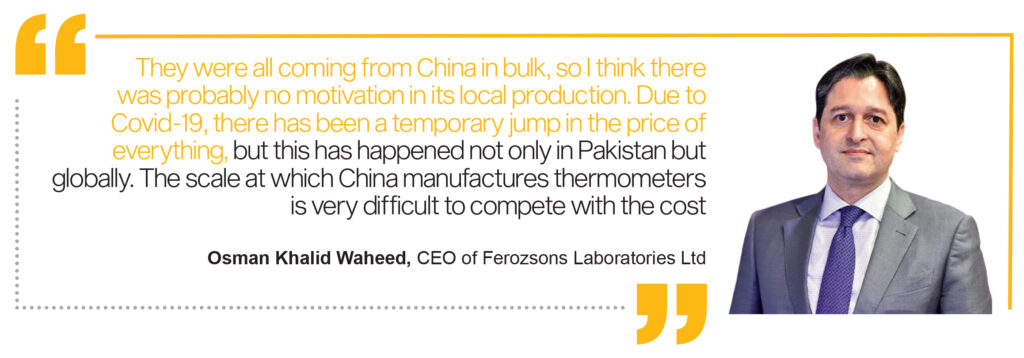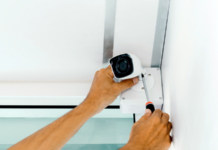While the Covid-19 pandemic has run rife and flipped entire businesses previously thought pillar of society to crumble, for many others, it has proven profitable. Companies like Zoom and products like surgical face masks have seen massive surges in demand and have prompted competitors to also spring up.
One sector where things in the economy have been going well, of course, was medical equipment. And while oximeters and scrub suits were less common purchases, one of the pieces of equipment that became necessary were thermometers. And in the last six months alone, according to a survey conducted by Profit, the price of thermometers has increased by as much as 200-300%.
Why have these prices gone up the way that they have? More importantly, why has it happened exactly at a time when people might want to buy more thermometers so they can keep tabs on their health and check quickly and safely whether or not they have Covid-19 symptoms or not? Profit talks to the wholesalers, manufacturers, and the Drug Regulatory Authority Pakistan (DRAP) to get to the bottom of the issue.
A larger issue
The first thing to understand is that this is not just the case with thermometers for some odd reason. Other equipment that is higher in demand because of the pandemic has also become much more expensive, and that makes a lot of sense. The only problem is, why haven’t the regulators managed to stay on top of this problem, and how bad has it exactly gotten.
This sentiment is what runs through most involved in the business. One wholesale dealer of medical devices, Muhammad Zulfiqar, who operates in the old Lohari market (which is one of the wholesale market of medical devices and medicines in Lahore) informed Profit that the recent fluctuation in prices of medicine and medical devices was drastic which has risen up to 300 times. “Surgical equipment is also facing this scenario,” he said.
As Zulfiqar explains, there are different types of thermometers for sale in the market. There are the classic glass and mercury kin, which are old fashioned but reliable and have been in use for decades. Then there are digital thermometers, which have plastic bodies, a metal tip, and a small display screen that tells you the temperature.
Finally, there are infrared thermometers, which you have seen at the entrance to any store or restaurant and are shaped like a gun. These require no contact with skin, and simply shoots out a laser that detects temperature and displays it on a small screen. These have become very popular in the past year because they are a necessity. “These devices have brought a lot of leisure and have made the procedure of evaluating temperature much easier.”

When asked about the current situation of the market, however, Zulfiqar says that this is not a lasting trend however, and that is something people involved in the business should know. “In recent months, Infrared thermometers have become wildly popular. People and organisations like this product despite its price.
The reason it is so popular is that it is the only device that can check temperature without any contact,” he says. “However, the quality of product remains a great concern for companies. But as the situation is getting normal, demand for IR thermometers is reducing day by day. Over the current ups and downs in recent months, import of mercury-in-glass was also affected immensely.”
Meawhile Muhammad Mubashir, a manager at Punjab Surgicals in Lahore told Profit that there was stiff competition between companies in the market that are trying to control the thermometer business. “Infrared thermometers, which have recently gained favour, are being sold by different companies at different rates starting from Rs1,500. The demand really started during the lockdown, and while more came on the market, the demand kept increasing as the need grew to the extent that there was a shortfall again even after production was ramped up,” he explains.
“As a result of this, different pharmacies or even companies have sold these thermometers in the market at rates up to 1000 times more than the original price. At one point when everyone was panicking to get these thermometers, since the government mandated that they have to be used before people enter places of business, thermometers were sold for as high as Rs 25,000 even in the early lockdown days.”
Glass thermometers
Then there are the traditional thermometers that we are all used to. One of the major problems with these, of course, is the fact that Pakistan does not produce thermometers itself. Currently, there is not a single production unit established in Pakistan, even for simple glass thermometers with mercury in them. And because of the lack of imports and factories being closed, inflation has increased across the board and especially for products like thermometers. As a result, a lot of manufacturers are looking to find some other ways of making thermometers.
The core cause, as the dealer shares, is the steadily increasing prices of mercury in the international market. “The substitute chemical is performing well up until now as most of the chemicals in glass thermometers are put in mouth in order to measure temperature and there is no harmful impact of this chemical as well.”
Awais Ali, an owner of a wholesale pharmacy franchise, informed Profit that there were two types of mercury in glass thermometers, one was called a clinical thermometer and the other one was known as a safety thermometer. “There is a great difference between the price of both meters but nowadays there is no fixed or control rate in the market as these items are not being produced by manufacturers. Manufacturers are not producing mercury in glass products as mercury is getting banned from China and other countries. Nowadays, there are very few dealers in the market who have these products but sell these at their own rates”.
Moreover, Awais informed that medical staff as well general people prefer digital meters now. “Mercury in glass meters is mostly made of glass. Therefore there is always danger of their setting being broken. Avoiding any type of danger people prefer using a digital thermometer. No hard skill is required to use these meters. They are simple and easy to use. Accuracy in digital meters is much better than that of mercury in glass.”
Abdul Razzaq who is an expert of the wholesale market of medical devices and has bee running a business for around 30 years was hopeful about the market situation.He believes that the market was improving and government officials were paying heed to various markets including medicine and surgicals.“Thermometers are a regular product normally. But in the past months when their requirements have surged swiftly, it becomes difficult to compete with their demand and supply for all traders. The black market has become visible on ground.”
Razzaq was hopeful that Pakistan is making progress by leaps and bounds and that the state will be independent in the near future in fulfilling the requirement of medical equipment, and then there will be an end need to import all the instruments.
Why do the prices go up in the first place?
According to Dr. Noor Mehr, President, Pakistan Drug Lawyers Forum, the prices of various medical devices go up suddenly because the system to control them is ineffective. While it is natural for demand to result in higher prices, this should never happen so unabashedly. “It is the job of the Drug Regulatory Authority of Pakistan (DRAP) to control the situation, but the authority is too small and there is a lot of work to be done,” he says.
“I am also an importer and keep ordering medical devices. Now the market of medical devices is about the same size as the pharmaceutical market. About 5,000 medical devices are imported into Pakistan. The government has increased the import duty by 65 per cent, which has significantly reduced imports, even if they are related to saving human lives. Another reason is that the DRAP has imposed very strict laws on medical imports, and even if someone’s consignment arrives legally, it takes a lot of effort to get it out of there and every device has to be registered first. The importer also runs away from this unnecessary burden and complexity. The government should simplify the system and increase the efficiency of the DRAP.”
On the other hand, a senior official of DRAP admits that thermometer prices have risen, but says there is no precedent for controlling the price of medical devices such as thermometers anywhere in the world. Speaking to Profit they said, “Even before the pandemic like coronavirus, the thermometer was undoubtedly a very important medical device, but since then the demand for it has increased tremendously. Now if we talk about price fixing or controlling of this device, in Pakistan, the open markets have always decided their prices.”
“We should also keep in mind the fact that if a thing was worth ten rupees before the lockdown, now it cannot be found again at the same price because it has become expensive. There are many factors that make things expensive and the biggest factor when it comes to thermometers is the rising prices of this device in international markets. Pakistan imports a large number of thermometers from China, but during the Covid-19 lockdown, many things were going to China from here because China itself was not able to meet the demands of its many needs.”
Another possible reason why thermometers are so expensive could be that the black market has been galvanised. When the importers here know that the demand for anything is increasing, they stockpile it and later sell it at a higher price and this practice is very old and is not just in this industry, but everywhere. Once again, while the DRAP points to this, they forget that it is their responsibility to make sure that the black market is not able to operate with impunity.
“At our divisional level, officers are often reluctant to carry out operations for which they make excuses, saying that the prices of these devices are not controlled all over the world, so why should we waste our energy on this. Even if the device was manufactured locally, its price could have been reduced, but to date no investor or industry has ever thought of investing in this sector and we have not received any application in this regard, so it is not our fault,” said the official.
“We must entertain every investor who is interested in setting up a pharmaceutical industry or unit. The business of manufacturing thermometers is one in which investors do not see much profit, which is why no one has ever come here. Its exports also do not have much potential as China and a few European countries have a large share in the international markets and supply thermometers to the whole world. However, its prices have also risen temporarily and as soon as some investors find out that there is a margin in this product and they start importing it, fresh competition will start which will cause the prices to come down again.”
Osman Khalid Waheed, Chief Executive Officer (CEO) of Ferozsons Laboratories Ltd, also endorses this claim of the DRAP Official to some extent, and says that there should be no obstacles in the local level manufacturing of thermometers and historically this device has been very cheap.“They were all coming from China in bulk, so I think there was probably no motivation in its local production. Due to Covid-19, there has been a temporary jump in the price of everything, but this has happened not only in Pakistan but globally. The scale at which China manufactures thermometers is very difficult to compete with the cost,” he said.
Waheed complained that the price control of some medicines should be done on a real basis while this is not the case in Pakistan. “The prices of our medicines are always regulated and all the quality manufacturers are under pressure under this price control structure. Now, if we talk about drugs like Angised or Thyroxine, their prices are very low, even in the local market, they cost one or two rupees. We have a simple chewing gum or toffee for five rupees and lifesaving drugs for one to two rupees.”
“In such cases, it becomes very difficult to maintain the supply and quality of low price medicines. It is very difficult to provide a pill that has medicine in it and it also affects the patient for one or two rupees. In such a price controlling structure, either waste will be sold or quality manufacturing will not be possible and the loss is ultimately to the patient. At the government level, it is said that they have fixed the price of the pill at thirty paisa, but then there is always a shortage of it in the market and the patient then imports what causes a separate loss to the patient and a separate loss to the manufacturer. Price control should be done keeping in view the real aspects.”
























